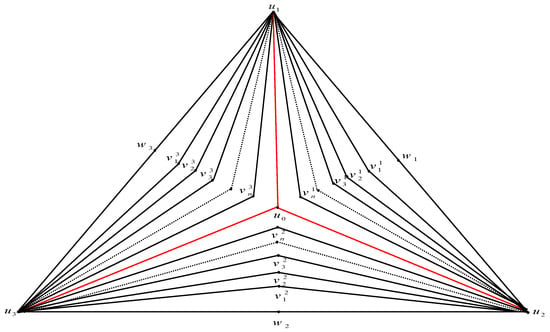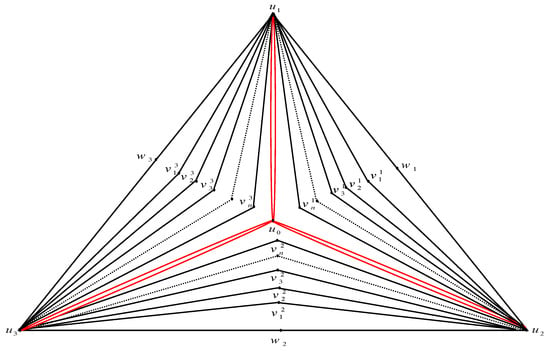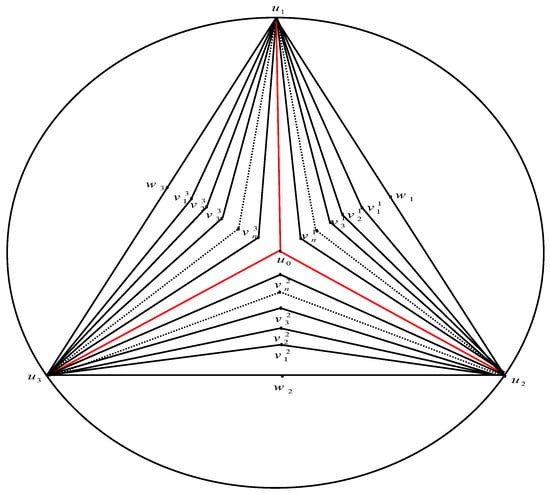Abstract
The methods of measuring the complexity (spanning trees) in a finite graph, a problem related to various areas of mathematics and physics, have been inspected by many mathematicians and physicists. In this work, we defined some classes of pyramid graphs created by a gear graph then we developed the Kirchhoff’s matrix tree theorem method to produce explicit formulas for the complexity of these graphs, using linear algebra, matrix analysis techniques, and employing knowledge of Chebyshev polynomials. Finally, we gave some numerical results for the number of spanning trees of the studied graphs.
MSC:
05C05; 05C50
1. Introduction
The graph theory is a theory that combines computer science and mathematics, which can solve considerable problems in several fields (telecom, social network, molecules, computer network, genetics, etc.) by designing graphs and facilitating them through idealistic cases such as the spanning trees, see [,,,,,,,,,].
A spanning tree of a finite connected graph is a maximal subset of the edges that contains no cycle, or equivalently a minimal subset of the edges that connects all the vertices. The history of enumerating the number of spanning trees of a graph dates back to 1842 when the physicist Kirchhoff [] offered the matrix tree theorem established on the determinants of a certain matrix gained from the Laplacian matrix defined by the difference between the degree matrix and adjacency matrix , where is a diagonal matrix, corresponding to a graph with vertices that has the vertex degree of in the ith position of a graph and is a matrix with rows and columns labeled by graph vertices, with a or in position according to whether and are adjacent or not. That is
where denotes the degree of the vertex
This method allows beneficial results for a graph comprising a small number of vertices, but is not feasible for large graphs. There is one more method for calculating . Let denote the eigenvalues of the matrix of a graph with vertices. “Kelmans” and “Chelnokov” [] have derived that
One of the favorite methods of calculating the complexity is the contraction–deletion theorem. For any graph , the complexity of is equal to , where e is any edge of , and where is the deletion of from , and is the contraction of e in . This gives a recursive method to calculate the complexity of a graph [,].
Another important method is using electrically equivalent transformations of networks. Yilun Shang [] derived a closed-form formula for the enumeration of spanning trees the subdivided-line graph of a simple connected graph using the theory of electrical networks.
Many works have conceived techniques to derive the number of spanning trees of a graph, some of which can be found at [,,].
Now, we give the following Lemma:
Lemma 1
[]. where are the adjacency and degree matrices of , the complement of , respectively, and is the identity matrix.
The characteristic of this formula is to express straightway as a determinant rather than in terms of cofactors as in Kirchhoff theorem or eigenvalues as in Kelmans and Chelnokov formula.
2. Chebyshev Polynomial
In this part we insert some relations regarding Chebyshev polynomials of the first and second types which we use in our calculations.
We start from their definitions, see Yuanping, et al. [].
Let be matrix such that
Furthermore, we render that the Chebyshev polynomials of the first type are defined by
The Chebyshev polynomials of the second type are defined by
It is easily confirmed that
It can then be shown from this recursion that by expanding one obtains
Moreover, by solving the recursion (3), one gets the straightforward formula
where the conformity is valid for all complex (except at , where the function can be taken as the limit).
The definition of easily yields its zeros and it can therefore be confirmed that
One further notes that
From Equations (6) and (7), we have:
Finally, straightforward manipulation of the above formula produces the following formula (9), which is highly beneficial to us later:
Moreover, one can see that
Now we introduce the following important two Lemmas.
Lemma 2
[]. Let be Circulant matrix such that
Then forone has
Lemma 3
[]. If , , and . Suppose that and are nonsingular matrices, then:
This Lemma gives a type of symmetry for some matrices which simplify our calculations of the complexity of graphs studied in this paper.
3. Main Results
Definition 1.

The pyramid graphis the graph created from the gear graphwith verticesandsets of vertices, say,such that for allthe vertexis adjacent toand,whereandis adjacent toandSee Figure 1.

Figure 1.
The pyramid graph .
Theorem 1.
For
Proof.
Using Lemma 1, we have
Let be the matrix with all one, and be the matrix with all one. Set and . Then we obtain:
Using Lemma 3, yields
Using Lemma 3 again, yields
Straightforward inducement using the properties of determinants, one can obtain
Using Lemma 2, yields
Using Equation (11), yields the result. □
Definition 2.

The pyramid graphis the graph created from the gear graphwith verticeswith double internal edges andsets of vertices, say,, such that for allthe vertexis adjacent toand, whereandis adjacent toandSee Figure 2.

Figure 2.
The pyramid graph .
Theorem 2.
For
Proof.
Using Lemma 1, we get:
Let be the matrix with all one, and be the matrix with all one. Set and . Then we get:
Using Lemma 3, yields
Using Lemma 3 again, yields
With a straightforward inducement using properties of determinants, we obtain
Using Lemma 2, yields
Using Equation (11), yields the result. □
Definition 3.

The pyramid graphis the graph created from the gear graphwith verticeswith double external edges andsets of vertices, say,, such that for allthe vertexis adjacent toand, whereandis adjacent toandSee Figure 3.

Figure 3.
The pyramid graph .
Theorem 3.
For
Proof.
Using Lemma 1, we have:
Let be the matrix with all one, and be the matrix with all one. Set and . Then we have:
Using Lemma 3, yields
Using Lemma 3 again, yields
Using properties of determinants, we have:
Using Lemma 2, yields:
Using Equation (11), yields the result. □
Definition 4.

The pyramid graphis the graph created from the gear graphwith verticeswith double internal and external edges andsets of vertices, say,, such that for allthe vertexis adjacent toand, whereandis adjacent toandSee Figure 4.

Figure 4.
The pyramid graph .
Theorem 4.
For
Proof.
Applying Lemma 1, we have:
Let be the matrix with all one, and the matrix with all one. Set and . Then we have:
Using Lemma 3, yields
Using Lemma 3, yields
Straightforward inducement using properties of determinants, we get:
Using Lemma 2, yields:
Using Equation (11), yields the result. □
4. Numerical Results
The following Table 1 illustrates some values of the number of spanning trees of studied pyramid graphs.

Table 1.
Some values of the number of spanning trees of studied pyramid graphs.
5. Conclusions
The number of spanning trees in graphs (networks) is an important invariant. The computation of this number is not only beneficial from a mathematical (computational) standpoint, but it is also an important measure of the reliability of a network and electrical circuit layout. Some computationally laborious problems such as the traveling salesman problem can be resolved approximately by using spanning trees. In this paper, we define some classes of pyramid graphs created by a gear graph and we have studied the problem of computing the number of spanning trees of these graphs.
Author Contributions
All authors contributed equally to this work. Funding Acquisition, J.-B.L.; Methodology, J.-B.L. and S.N.D. Daoud; Writing—Original Draft, J.-B.L. and S.N.D. Daoud; All authors read and approved the final manuscript.
Funding
The work was partially supported by the China Postdoctoral Science Foundation under grant No. 2017M621579 and the Postdoctoral Science Foundation of Jiangsu Province under grant No. 1701081B, Project of Anhui Jianzhu University under Grant no. 2016QD116 and 2017dc03, Anhui Province Key Laboratory of Intelligent Building & Building Energy Saving.
Acknowledgments
The authors are grateful to the anonymous reviewers for their helpful comments and suggestions for improving the original version of the paper.
Conflicts of Interest
The authors declare that there are no conflicts of interest regarding the publication of this paper.
References
- Applegate, D.L.; Bixby, R.E.; Chvátal, V.; Cook, W.J. The Traveling Salesman Problem: A Computational Study; Princeton University Press: Princeton, NJ, USA, 2006. [Google Scholar]
- Cvetkoviĕ, D.; Doob, M.; Sachs, H. Spectra of Graphs: Theory and Applications, 3rd ed.; Johann Ambrosius Barth: Heidelberg, Germany, 1995. [Google Scholar]
- Kirby, E.C.; Klein, D.J.; Mallion, R.B.; Pollak, P.; Sachs, H. A theorem for counting spanning trees in general chemical graphs and its particular application to toroidal fullerenes. Croat. Chem. Acta 2004, 77, 263–278. [Google Scholar]
- Boesch, F.T.; Satyanarayana, A.; Suffel, C.L. A survey of some network reliability analysis and synthesis results. Networks 2009, 54, 99–107. [Google Scholar] [CrossRef]
- Boesch, F.T. On unreliability polynomials and graph connectivity in reliable network synthesis. J. Graph Theory 1986, 10, 339–352. [Google Scholar] [CrossRef]
- Wu, F.Y. Number of spanning trees on a Lattice. J. Phys. A 1977, 10, 113–115. [Google Scholar] [CrossRef]
- Zhang, F.; Yong, X. Asymptotic enumeration theorems for the number of spanning trees and Eulerian trail in circulant digraphs & graphs. Sci. China Ser. A 1999, 43, 264–271. [Google Scholar]
- Chen, G.; Wu, B.; Zhang, Z. Properties and applications of Laplacian spectra for Koch networks. J. Phys. A Math. Theor. 2012, 45, 025102. [Google Scholar]
- Atajan, T.; Inaba, H. Network reliability analysis by counting the number of spanning trees. In Proceedings of the IEEE International Symposium on Communications and Information Technology, ISCIT 2004, Sapporo, Japan, 26–29 October 2004; pp. 601–604. [Google Scholar]
- Brown, T.J.N.; Mallion, R.B.; Pollak, P.; Roth, A. Some methods for counting the spanning trees in labelled molecular graphs, examined in relation to certain fullerenes. Discret. Appl. Math. 1996, 67, 51–66. [Google Scholar] [CrossRef]
- Kirchhoff, G.G. Uber die Auflosung der Gleichungen, auf welche man be ider Untersuchung der Linearen Verteilung galvanischer Storme gefuhrt wird. Ann. Phys. Chem. 1847, 72, 497–508. [Google Scholar] [CrossRef]
- Kelmans, A.K.; Chelnokov, V.M. A certain polynomials of a graph and graphs with an extermal number of trees. J. Comb. Theory B 1974, 16, 197–214. [Google Scholar] [CrossRef]
- Biggs, N.L. Algebraic Graph Theory, 2nd ed.; Cambridge University Press: Cambridge, UK, 1993; p. 205. [Google Scholar]
- Daoud, S.N. The deletion-contraction method for counting the number of spanning trees of graphs. Eur. Phys. J. Plus 2015, 130, 217. [Google Scholar] [CrossRef]
- Shang, Y. On the number of spanning trees, the Laplacian eigenvalues, and the Laplacian Estrada index of subdivided-line graphs. Open Math. 2016, 14, 641–648. [Google Scholar] [CrossRef]
- Bozkurt, Ş.B.; Bozkurt, D. On the Number of Spanning Trees of Graphs. Sci. World J. 2014, 2014, 294038. [Google Scholar] [CrossRef] [PubMed]
- Daoud, S.N. Number of Spanning Trees in Different Product of Complete and Complete Tripartite Graphs. ARS Comb. 2018, 139, 85–103. [Google Scholar]
- Daoud, S.N. Complexity of Graphs Generated by Wheel Graph and Their Asymptotic Limits. J. Egypt. Math. Soc. 2017, 25, 424–433. [Google Scholar] [CrossRef]
- Daoud, S.N. Chebyshev polynomials and spanning tree formulas. Int. J. Math. Comb. 2012, 4, 68–79. [Google Scholar]
- Zhang, Y.; Yong, X.; Golin, M.J. Chebyshev polynomials and spanning trees formulas for circulant and related graphs. Discret. Math. 2005, 298, 334–364. [Google Scholar] [CrossRef]
- Daoud, S.N. On a class of some pyramid graphs and Chebyshev polynomials. J. Math. Probl. Eng. Hindawi Publ. Corp. 2013, 2013, 820549. [Google Scholar]
- Marcus, M. A Survey of Matrix Theory and Matrix Inequalities; University Allyn and Bacon. Inc.: Boston, MA, USA, 1964. [Google Scholar]
© 2018 by the authors. Licensee MDPI, Basel, Switzerland. This article is an open access article distributed under the terms and conditions of the Creative Commons Attribution (CC BY) license (http://creativecommons.org/licenses/by/4.0/).